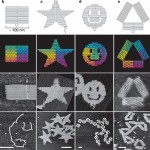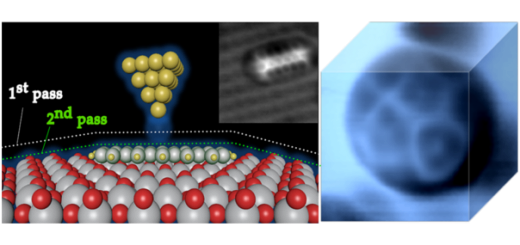Building Nano-Lenses Based on DNA Origami Structures
When: Friday, 20 November (2015), 12:00h
Place: Departamento de Física de la Materia Condensada, Facultad Ciencias, Module 3, Seminar Room (5th Floor).
Speaker: Guillermo Acuña, TU Braunschweig, Institute of Physical and Theoretical Chemistry, Hans-Sommer-Str. 10, Braunschweig, Germany.
Abstract:
In this presentation, we will show how the DNA-Origami technique [1] (Figure 1.) can be introduced for plasmonic and photonic applications. Firstly, we employ DNA-Origami as a platform where metallic nanoparticles as well as single organic fluorophores can be organized with nanometer precision in three dimensions. With these hybrid structures we initially study the nanoparticle-fluorophore interaction in terms of the distance-dependent fluorescence quenching [2] and angular dependence around the nanoparticle [3]. Based on these findings, we build highly efficient nano-lenses (Figure 2.) based on 100 nm gold dimers [4] which are able to strongly focus light into the sub-wavelength region where the fluorophore is positioned and produce a fluorescence enhancement of more than two orders of magnitude [5].
Using this highly confined excitation field we were able to perform single molecule measurements in solution at concentrations as high as 25µM in the biologically relevant range. Additionally, we report on a controlled increment of the radiative rate of organic dyes in the vicinity of gold nanoparticles with the consequent increment in the number of total emitted photons [6,7].
References
- P. W. Rothemund, Nature 440, (2006) 297.
- G. P. Acuna et al., ACS Nano 6, (2012) 3189.
- F. Möller, P. Holzmeister, T. Sen, G. P. Acuna and P. Tinnefeld, Nanophotonics 2, (2013) 167.
- G. P. Acuna et al., Science 338, (2012) 506.
- A. Puchkova et al., Nano Letters, just accepted (2015).
- J. Pellegrotti et al., Nano Letters 14, (2014) 2831.
- P. Holzmeister, E. Pibiri, J.J. Schmied, T. Sen, G. P. Acuna and P. Tinnefeld, Nat. Comm. 5, (2014) 5356.





















